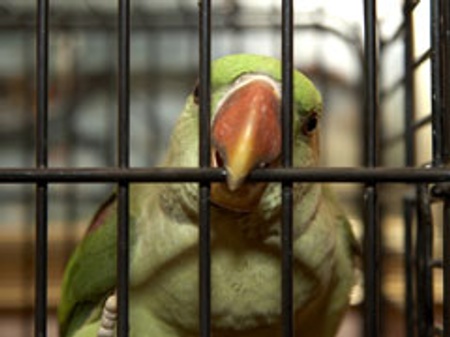Rats. Cats. Rabbits. Dogs.
Monkeys.
These are the animals we imagine locked up in vivisection labs, subjected to hurtful and often perverse experiments the purpose of which — beyond the satisfaction of abstract curiosity — is often unclear. Cats and rabbits burned by noxious poisons. Rats purposely starved to death. Dogs trapped in cages with electrified floors. Monkeys subjected to repeated psychosurgery. Apes infected with HIV.
Let it be said: There’s no excuse for any of this. Even if animal experimentation really was a good way to test medicines or learn things people feel they need to know, it’s never ethical to experiment on a non-consenting subject. The animals do not consent. Might doesn’t make right. “Because we can” is not a logical ethical justification of any activity
Birds are locked up in labs too. Look up “zebra finch songs” on Google Scholar and the first study you’ll see describes deliberately deafening and mutilating the brains of these birds. Why? Because we’re curious about why and how they sing as they do. Scores of studies involving heaven-knows-how-many of these birds have been published on that one question, earning their authors grants and tenure (and undoubtedly making profits for the vendors of birds and supplies) but doing nothing for the birds except torturing them.

That’s just one example of gross misconduct involving avians. There are many, many more. Nobody knows how many, because birds are lumped together with mice and rats in accounting. Why? Because all three are specifically exempted from protection by animal welfare provisions concerning vivisection even though, together, they account for more than 95% of animals used in research.
Chickens and other farmed animals are vivisected not only in the course of so-called “basic research” but also in the course of agricultural research intended to make the exploitation of others of their kind more easy and profitable
Genetic engineering is a particularly problematic kind of experimentation on chickens and other farmed animals. Many animals are sacrificed — including unwitting “donors” of genetic material as well as multiple unwilling “surrogate” mothers for every — to produce genetically modified offspring who often suffer debilitating ailments. The Gene and the Stable Door (pdf) published by Compassion in World Farming is perhaps the best reference on this increasingly common kind of animal abuse.
Karen Davis of United Poultry Concerns has published two important essays on genetic engineering of chickens, “The Ethics of Genetic Engineering and the Futuristic Fate of Domestic Fowl” and “Genetic Engineering and Cloning of Domestic Fowl.”
Public opposition to genetic engineering of any kind is high. Opposition to genetic modification of corn and other food plants runs particularly high among environmentalists and among activists opposed to trade globalization. The facts about genetic engineering of animals are less well known but even more shocking than those that have sparked mass actions against terminator seeds and other atrocities. By educating the public and other activists about genetic modification of animals, animal advocates can make sure the interests of animals are represented in the struggle against genetic engineering. By showing solidarity with environmental and social justice activists opposed to other kinds of agricultural genetic engineering, animal advocates can take the first steps toward coalition.
This is an entry in the Carnival Against Vivisection. See SuperWeed for details.



